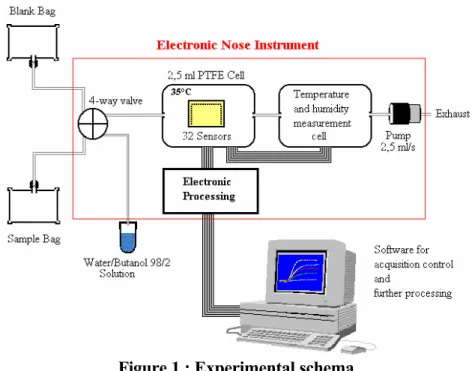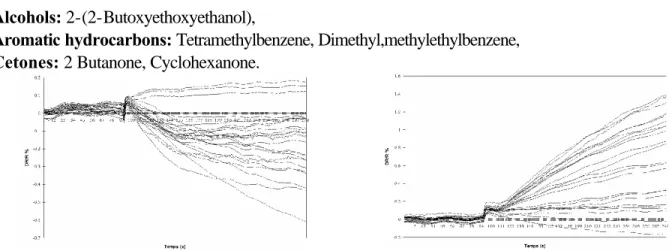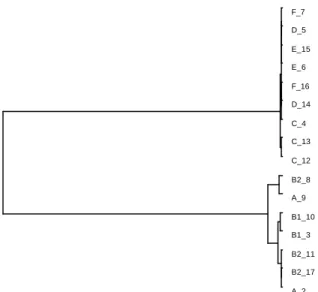HAL Id: hal-00688501
https://hal.archives-ouvertes.fr/hal-00688501
Submitted on 17 Apr 2012HAL is a multi-disciplinary open access archive for the deposit and dissemination of sci-entific research documents, whether they are pub-lished or not. The documents may come from teaching and research institutions in France or abroad, or from public or private research centers.
L’archive ouverte pluridisciplinaire HAL, est destinée au dépôt et à la diffusion de documents scientifiques de niveau recherche, publiés ou non, émanant des établissements d’enseignement et de recherche français ou étrangers, des laboratoires publics ou privés.
Discrimination of paint emission using an electronic nose
Olivier Ramalho, Chaouki Regoui, Séverine Kirchner
To cite this version:
Olivier Ramalho, Chaouki Regoui, Séverine Kirchner. Discrimination of paint emission using an electronic nose. 4th International Conference on Characterization and Control of Emissions of Odors and VOCs, Oct 1997, Montreal, Canada. pp.409-418. �hal-00688501�
Communication: 4 congrés international sur la caractérisation et la réduction des Communication: 4 congrés international sur la caractérisation et la réduction des
émission
émissions d’odeurs et de COVs d’odeurs et de COV --Montréal, Octobre 1997Montréal, Octobre 1997
Discrimination of paints emissions by means of an electronic nose
Olivier RAMALHO Ê, Chaouki REGOUI ÊË, Séverine KIRCHNER ÊÊ Centre Scientifique & Technique du Bâtiment, CSTB, service EAE, BP02 77421 Marne-la-Vallée Cedex2, France, &:33.1.64.68.82.66, fax:33.1.64.68.84.73,e-mail: kirchner@cstb.fr
Ë Laboratoire SIP, université Paris V, UFR Mathématiques-Informatique, 45 rue des saints pères 75006 Paris, France, fax:33.1.44.55.35.36, e-mail: regc@math-info.univ-paris5.fr
ABSTRACT
Several paints of two types were chosen to assess an air quality monitoring tool based on an electronic nose. We are trying to improve the discrimination capability of the system by means of pattern recognition techniques.
The electronic nose we use is based on conducting polymer sensors. The paint samples were acquired using an acquisition protocol that was previously defined and a data base was constituted.
INTRODUCTION
The use of new synthetic materials such as carpets, plastic tiles, paints etc. in residences, commercial or public buildings has been increasing these last decades in relation with comfort improvements, noise reduction, energy savings as well as psychological well being. During the same time, the number of complaints about adverse effects on comfort and health associated with the use of such materials has been increasingly reported and the volatile organic compounds (VOCs) emission has been frequently addressed as a possible cause in the debates on indoor air quality problems.
Several physico-chemical techniques (GC/MS, HPLC etc.) have been used in order to evaluate indoor air quality (IAQ) by assessing individual VOCs emitted by building materials and furnishings [1, 2]. On the other hand, subjective human analysis allowing assessment of odor intensity [3] or acceptability [4,5] has been developed. However, these techniques are time consuming, expensive and not able to perform real time evaluation.
Promising techniques such as multi gas sensor systems (also named electronic noses) have been
developed and used in several fields such food, packaging, cosmetic and car industry and, more recently, for some environmental applications such as space, ambient and indoor air. Based on different kind of active materials (sintered metal oxide, phtalocyanines, conducting polymer, quartz crystals ...), available sensors are used for their broad specificity, and because, when they are used in arrays, they can discriminate complex chemical mixtures without separation of individual compounds. As such, an electronic nose is an instrument trying to mimic the human olfaction [6,7].
The aim of the research conducted at CSTB is the development of a real time air quality monitoring tool using an electronic nose based on conducting polymer sensors and artificial neural network pattern recognition technique. The first part of the work presented here is the evaluation of the discrimination capability of such electronic nose regarding VOCs frequently emitted by the building materials. The experimental methodology as well as the results obtained are presented below.
Methodology
The work is based on an electronic nose constituted with a layer of 32 conducting polymer sensors, sensitive to a stimulus (volatile compounds) by producing time-dependent electric signals which are processed independently afterwards to produce a multi-dimensional vector. This vector represents the pattern of the stimulus, it is then checked for identification against a database containing similar vectors by pattern recognition techniques which are either statistical methods (principal component analysis,
discriminant function analysis being the most used) or artificial neural network techniques.
Figure 1 : Experimental schema
This work uses an electronic nose based on conducting polymers with a pattern recognition tool. It concerns the evaluation of the discrimination power of the system to three paintings containing acrylic resins named A, B1, B2 and four glycerophtalic paintings named C, D, E, F.
Acrylic paints:
1,2 Propanediol, 2-(2-Butoxyethoxyethanol), 2 Methylpropanoate of ( 1 tertiobutyl , 2 methyl, 3 hydroxy )propyle,2 Methylpropanoate of ( 2 ethyl , 3 hydroxy )hexyle
Figure 2 : time dependent response (% ∆∆R/R) of two acrylic paints (A_2, A_9, B1_3)
Glycerophtalic paints:
Aliphatic hydrocarbons: Heptane, Dodecane, Dimethylnonane, Methyldodecane, Dimethyldodecane, Aldehydes: Pentanal, Hexanal, 2 Heptenal,
Alcohols: 2-(2-Butoxyethoxyethanol),
Aromatic hydrocarbons: Tetramethylbenzene, Dimethyl,methylethylbenzene, Cetones: 2 Butanone, Cyclohexanone.
Figure 2 : time dependent response (% ∆∆R/R) of two glycerophtalic paints (C_4, C_12, C_13)
The discrimination is based on the different interaction energies between active sites scattered in the conducting polymer film and the volatile compounds giving rise to different levels of variation in the bulk electronic conductivity of each sensor [8]. These molecular interactions are dependent on the nature and structure of sites and compounds alike. The problem is to determine if the system is able to recognize small variations in the nature or the structure of samples. An ideal discrimination power being represented by the recognition of the smallest variation with regard to a reference compound.
Experimental protocol
Sampling rate : 1 second, Reference 90 seconds, Sampling 210 seconds
The tests were realized by injection with a syringe of a known volume of the pure liquid compound in a sample bag filled with 700 ml of synthetic air at a relative humidity of 15-20% (at ambient temperature : 20-25°C). Each sample bag was then tested against a blank bag filled with synthetic air after an equilibrium time sufficient to the total liquid -vapor transition (Figure 1). The response obtained is then expressed in percent of relative resistance variation of each sensor (% ∆R/R). After each acquisition the sensors were cleaned with a 98/2 water/n-butanol saturation vapor during 210 seconds and again exposed to clean air.
For each compound the injected volume is determined by the saturation vapor pressure and relatively by the other compounds in order to obtain the same magnitude of the global response (sum of the 32 responses for one test). The last parameter allows to keep the signal/noise ratio constant along the experiments. It gives a same level of noise for all the measurements allowing the comparison of the results even if the concentration used for each compound was different. Ten replicates were realized for each compound. The concentration level used varies from 1920 part per million (ppm) for ethylbenzene to 4300 ppm for styrene. All relative standard deviations were within 2% of the concentration. Statistical data analysis was used to analyse the data obtained.
The paints were applicated on a glass substrate and dried for 24 Hours in the laboratory conditions. To do the measurements, every glass was put into a Tedlar sampling bag witch was sealed and fulled of 1 liter of synthetic air. Equilibrium time was fixed to 15 minutes. The measurements for every pain were realized after 24 hours and 48 hours of drying. On an other hand, the paintings were tested in a simulation chamber to determinate and quantify the COVs emitted by adsorption on Tenax TA cartridges by
thermodesorption coupled with a gas chromatography equipped with a flame ionization detector and a mass spectrometer.
The data were analyzed by comparing two phases of the signal : a) the dynamic phase, corresponding to the beginning of the adsorption/desorption process giving rise to an important response change; b) the
static phase, corresponding to the equilibrium in the adsorption/desorption process with a stabilized response level.
Figure 1 : Static and dynamic phases definition
RESULTS
A_2 B2_17 B2_11 B1_3 B1_10 A_9 B2_8 C_12 C_13 C_4 D_14 F_16 E_6 E_15 D_5 F_7
Figure 3: static phase, P.C.A and hierarchical classification
Dynamic phase
A_2 B2_17 B1_3 C_12 C_13 C_4 D_14 E_15 F_16 D_5 F_7 E_6 B1_10 B2_11 A_9 B2_8
Figure 3: dynamic phase, P.C.A and hierarchical classification
The electronic nose response profiles of the two types of paintings were different due to the difference of the chemical mixtures involved in every type of painting.
The acrylic painting emit globally glycols and glycol esters that gave a high positive response from the sensors while glycerophtalic paintings presented carboxylic compounds that are aldehydes and carboxylic acids inducing negative responses of the sensors.
About the 24 and 48 hours time drying, the two groups of paintings were distinguished even if one exception was encountered for a glycerophtalic painting split between the two groups depending on the drying time. The profile of that painting has changed over time (between 24 and 48 hours time drying) the carboxylic compounds that were detected after 24 hours drying became very low after 48 hours inducing a negative response profile.
CONCLUSION
The evaluation of the discrimination capability of an electronic nose as regards VOCs frequently emitted by the building materials has been studied. The discrimination between the acrylic and glycerophtalic paintings was obtained by using the electronic nose.
The system helped discriminate between the two types of paintings on a global basis (being sensitive to the whole mixture of every painting)
We are now completing a sensory panel evaluation of the paintings on an intensity basis and trying to correlate it with the electronic nose responses
ACKNOWLEDGMENTS
The financial support of the Agence de l'Environnement et de la Maîtrise de l'Energie (ADEME) and the Association Nationale de la Recherche Technique (ANRT) is kindly acknowledged.




